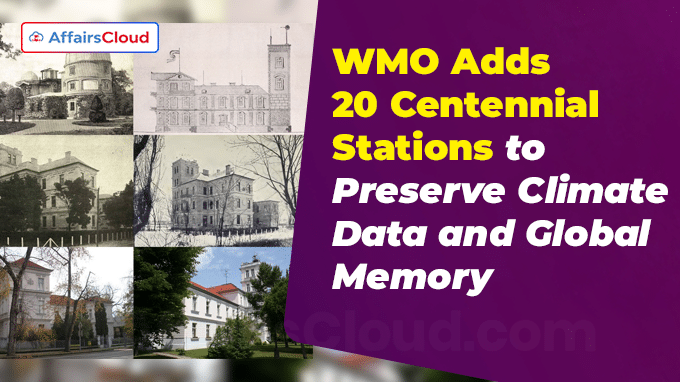 In June 2025, Geneva (Switzerland) based World Meteorological Organisation (WMO) Executive Council (EC) has recognised 20 new Centennial Observing Stations(COS). Each of these stations holds over a century of uninterrupted, high-quality data that are considered crucial assets in the global climate monitoring network.
In June 2025, Geneva (Switzerland) based World Meteorological Organisation (WMO) Executive Council (EC) has recognised 20 new Centennial Observing Stations(COS). Each of these stations holds over a century of uninterrupted, high-quality data that are considered crucial assets in the global climate monitoring network.
- With the addition of these new stations, the total number of COS has increased to 475, comprising 377 meteorological, 63 hydrological, and 15 marine stations.
Note: In May 2017 WMO EC meeting formally recognised the 1st set of WMO COS.
Key Points:
i.The newly recognized Centennial Stations include: Namibia (5 stations), Vietnam (2 stations), Portugal (5 stations), the United States of America (USA) (4 stations), Norway (3 stations) and France (1 station).
ii.Among these 20 newly recognized Centennial Stations, Susquehanna River hydrological stations (in the USA) is the oldest station, which dates back to 1786.
About Centennial Observing Stations(COS):
i.COS are weather, hydrological, or marine monitoring stations that have maintained continuous, high-quality observations for 100 years or more.
- Long-term meteorological observations are important in addressing the needs of current and future generations for long-term high quality climate records.
ii.Recognized by the WMO, these stations are invaluable for preserving historical climate data, which are essential for understanding past climate behavior and informing future projections.
iii.It supports scientists in tracking extreme weather trends, validating satellite data, improving disaster preparedness, and monitoring global warming.
iv.They also contribute real-time data to WMO’s World Weather Watch system and aid in preparing the State of the Global Climate reports, while supporting global climate goals under the United Nations Framework Convention on Climate Change (UNFCCC).
Criteria for Recognition:
To qualify as a Centennial Observing Station, a facility must fulfill the following conditions:
i.It must have been established at least 100 years ago.
ii.It should demonstrate continuous operational records with minimal interruptions.
iii.It must maintain high-quality observational data with well-preserved historical archives.
iv.The station should have a stable geographic location to ensure reliable climatological consistency over time.
Points to Note:
As of May 2025, a total of 15 Indian stations have been recognised as CSO by the WMO.
- In 2021, there are 12 WMO-recognised stations in 12 Indian stations: Ahmedabad (Gujarat), Alipore (West Bengal, WB), Gopalpur (Odisha), Mumbai (Maharashtra), Nungambakkam (Tamil Nadu, TN), Panjim (Goa), Patna (Bihar), Port Blair (Andaman & Nicobar Islands), Pune (Maharashtra), Puri (Odisha), Srinagar (Jammu & Kashmir, J&K) and Thiruvananthapura (Kerala).
- In 2023, WMO recognised 3 observatories of the Indian Meteorological Department (IMD): Dwarka and Verval (Gujarat) and Cuttack (Odisha).
About World Meteorological Organisation (WMO):
It is a specialized agency of the United Nations (UN) responsible for promoting international cooperation on atmospheric science, climatology, hydrology and geophysics.
Secretary General- Professor Celeste Saulo (Argentina)
Headquarters- Geneva, Switzerland
Established- 1950



